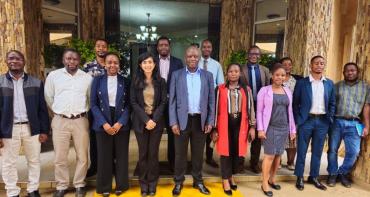Blog by Neil Balchin, Economic Adviser, International Trade Policy Section

The leaders of the world’s 46 least developed countries (LDCs) are meeting at the United Nations Headquarters in New York on March 17th, 2022 to adopt the Doha Programme of Action (DPoA), setting a renewed agenda for development in LDCs.
Practical and innovative ways to accelerate inclusive economic transformation should be at the forefront of this agenda.
Despite progressively greater emphasis on building productive capacity and enabling economic diversification in the DPoA’s immediate predecessors, most LDCs made only limited headway in transforming the structure of their economies. The devastating impacts of COVID-19 on production, trade and investment in LDCs, and its wider economic and social effects, have stalled progress even further. (The two most recent programmes of action for LDCs preceding the DPoA were the Brussels Programme of Action (2000-2010) and the Istanbul Programme of Action (2011-2020).)
A mixed picture of structural transformation in LDCs over two decades
Despite registering steady economic growth that has generally outpaced other developing countries, most LDCs have struggled to structurally transform their economies and diversify their production and exports.
Economic transformation happens when labour and other factors of production move from lower- to higher-productivity activities. This may occur as these inputs shift from low to higher value activities within the same sector, thereby raising sectoral productivity. Alternatively, it may happen as labour and other resources move across sectors, for instance from low-productivity agriculture to higher-productivity manufacturing and services, raising the overall productivity of the economy. (LDCs may pursue different development models based on the characteristics of their individual economies. These range from agriculture and agro-processing based transformation to manufacturing- or services-led economic transformation models.)
A comparison of cross-sectoral movements of labour from the start of the Brussels Program of Action in 2000 to the back end of the Istanbul Program of Action (IPoA) in 2019 reveals three distinct transformation patterns (Figure 1):
- 27 LDCs (Panel A) saw labour move out of agriculture and into both industry and services, with the largest overall shifts observed in Burkina Faso, Cambodia, Rwanda, Bangladesh, Comoros, Afghanistan and Zambia. In almost all cases for these diverse transformers, the relative increases in services employment shares were notably larger.
- 17 LDCs underwent services-driven transformation (Panel B), recording falling agriculture and industry shares alongside rising services contributions to total employment. These shifts were greatest in Yemen, Djibouti, Sao Tome and Principe, Benin, Mauritania and The Gambia; yet only the first four countries registered increases in services shares exceeding 10 per cent.
- In two LDCs, Angola and Uganda, the relative contribution of agriculture has increased since the start of the millennium, while the industry and services shares have declined in relative terms (Panel C). In Uganda, workers in the agriculture sector are engaged primarily in subsistence farming and higher value agro-processing capacity remains underdeveloped and underutilised. Similarly, agriculture in Angola is mostly concentrated in communal and subsistence farming to produce raw agricultural commodities.
Figure 1. Changes in the employment shares of agriculture, industry and services, 2000-02 vs. 2017-19 averages

Notes: These shares are computed using 3-year averages for 2000-02 and 2017-19. No data available for Kiribati or Tuvalu.
Source: Author’s calculations using World Bank World Development indicators data (ILO modelled estimates)
For many of the better performing LDCs in Figure 1, structural transformation has been most evident in the movement of labour into services sectors. Growing manufacturing capacity and accelerating industrial development remains challenging for many LDCs.
Indeed, several LDCs have experienced relative de-industrialisation of their economies over the past two decades. Some countries, notably Burundi and Eritrea, recorded both negative annual growth in manufacturing value added (VA) between 2000 and 2020, and declining shares of manufacturing in total VA (Figure 2). While average growth rates in manufacturing VA were positive in the other LDCs, the relative contribution of manufacturing to total VA declined in more than half (27) of them. Growth in manufacturing VA in these countries has not kept pace with the VA contributions of other sectors.
However, these trends do not tell the whole story across the LDC group. Some LDCs performed better at growing manufacturing capacity over the past two decades, with 13 registering both positive growth in manufacturing VA and rising shares of manufacturing in overall VA. (Angola, Bangladesh, Central African Republic, Djibouti, DR Congo, Guinea, Guinea-Bissau, Haiti, Madagascar, Mali, Myanmar, Togo and Uganda.)
Yet, it is in services where many LDCs are making more transformative progress. Average growth rates of services VA were positive in all LDCs between 2000 and 2020, and the contribution of services to total VA increased in 25 LDCs over this period (Figure 3).
Figure 2. The relative evolution of manufacturing VA in LDCs, 2000-2020

Note: No data available for Comoros, Liberia, Solomon Islands, Somalia and South Sudan.
Source: Author’s calculations using World Bank World Development indicators data
Figure 3. The relative evolution of services VA in LDCs, 2000-2020

Note: No data available for Eritrea, Solomon Islands, Somalia and Tuvalu.
Source: Author’s calculations using World Bank World Development indicators data
Accelerating LDCs’ economic transformation through a new programme of action
While most LDCs have made some progress in transforming their economic structures, many still face an array of binding constraints. A lack of technological capabilities, infrastructure deficiencies (especially in digital infrastructure), low productivity and limited capacity in manufacturing and other productive sectors, a lack of economic diversification, high levels of dependence on commodities and natural resources, low investment rates and limited government capacity to implement growth-oriented structural policies have all combined to impede faster progress.
Addressing these constraints is crucial for the long-term development of LDCs and will be the main driver of their transition from low- to middle- and, ultimately, high-income status. It will also help ensure their economies are more resilient to future shocks. Overcoming obstacles to economic transformation will enable LDCs to transition to a more sustainable growth path characterised by higher incomes, more productive employment, continued poverty reduction and more inclusive economic, human and social development.
The Commonwealth Secretariat’s 10-point programme of action for LDCs presents a targeted plan to address their special needs and improve their trade and development prospects.
The 10-point programme of action is designed based on a review of the progress and challenges encountered by Commonwealth LDCs during the IPoA. While it focuses on Commonwealth LDCs, many of the constraints and issues identified are not unique to these countries and are symptomatic of the challenges facing the broader LDC group.
One of the 10 action points stresses the need to accelerate the development of productive capabilities and drive structural transformation in LDCs. This can be supported through targeted actions and priorities in the DPoA that:
- Ensure better access to new technologies and enhance capabilities for innovation. Priorities should include strengthening the United Nations Technology Bank for LDCs to better support access to technologies, and ramping up investment in science, technology and innovation. LDC governments and their development partners should also look to develop domestic technologies that meet local needs by supporting research and development initiatives in these countries. This can play a catalytic role in raising productivity and supporting more advanced production focused around more complex and differentiated products and services.
- Raise the level of financial resources available for productive development. Emphasis should be placed on helping LDCs to boost investment in key productive sectors and deploy financial inflows from remittances as a development resource to enhance productive capacity. LDCs also need support to improve domestic resource mobilisation.
- Upgrade and diversify the domestic enterprise base. This requires interventions that assist LDCs to develop human capital and improve access to finance. LDCs also need to prioritise efforts to attract foreign direct investment that helps to develop linkages with local enterprises and transfers skills and technology to the domestic private sector.
These measures should form part of an ambitious new DPoA. When taken together with the other actions proposed in the Commonwealth’s 10-point plan — especially those aimed at strengthening support for LDCs to achieve inclusive and sustainable economic recovery from COVID-19; enhancing trade linkages with the developing world; deepening regional integration and connectivity; closing digital divides; leveraging digital technologies to boost trade, productive development and competitiveness; and growing the capacity of Commonwealth LDCs to attract productive investment — they can drive more discernible progress in overcoming the many structural impediments confronting LDCs.
Acknowledgement
The author is grateful for valuable comments and suggestions by Salamat Ali, Kimonique Powell, Brendan Vickers and Collin Zhuawu on an earlier draft.



